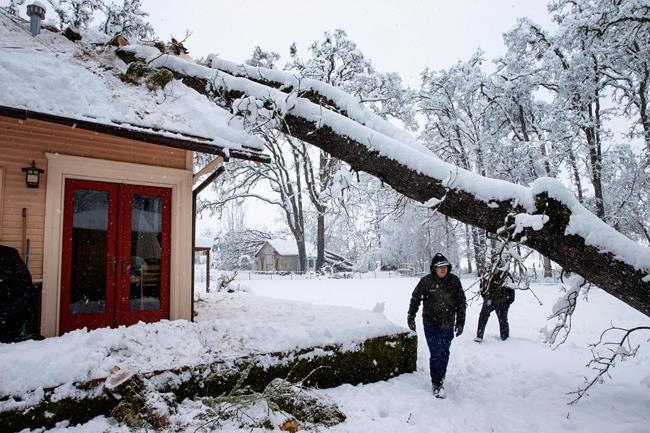
Bobby Roberts walks under tree that fell on a house on North 6th Street in Creswell, Ore., Monday, Feb. 25, 2019, after a heavy snow blanketed the Willamette Valley. He and a group of other volunteers were helping to remove the tree for the owner who was out of town when the storm hit. (Chris Pietsch/The Register-Guard via AP)
Republished February 25, 2019 - 6:00 PM
Original Publication Date February 25, 2019 - 10:01 AM
RENO, Nev. - A fierce winter storm packing winds in excess of 100 mph (160 kph) and predicted to bring as much as 8 feet (2.4 metres) of snow to the Sierra Nevada barrelled into the West on Monday, toppling trucks and trees, triggering power outages and closing roads and schools from Oregon to Montana.
Up to a foot (30 centimetres) of snow already had fallen in parts of Oregon, cancelling flights in Portland. A blizzard warning was in effect in parts of Montana, where one school district cancelled classes for the first time in two decades and whiteout conditions were reported in the Bitterroot Valley near Missoula.
Winds gusting to 110 mph (177 kph) were recorded at the summit of the Squaw Valley ski resort near Lake Tahoe, and up to 84 mph (135 kph) in the valleys along the Sierra's eastern front where Interstate 580 was closed off-and-on between Reno and Carson City.
Two trucks overturned on I-580 and another on nearby U.S. 395 in the Washoe Valley, where one non-life threatening injury was reported. At one point as many as 6,000 NV Energy customers were without power in the Reno-Sparks area.
A swath of western Montana from Missoula through the Bitterroot Valley was under a blizzard warning through Monday evening, with an inch or two (2.5 to 5 centimetres) of snow expected to fall each hour.
The National Weather Service has issued winter storm warnings and advisories for most of the rest of Montana through Tuesday morning. Butte public schools cancelled classes Tuesday for the first time in at least 20 years. Buses were getting stuck, and a superintendent told The Montana Standard that the district's snowplows haven't been able to keep up.
Hamilton declared a snow emergency, with up to 18 inches (46 centimetres) expected to fall there and in Anaconda by Tuesday.
Schools throughout Oregon delayed start times or closed altogether on Monday. About a foot of snow (30 centimetres) was reported in areas including Eugene and Bend. The city of Eugene declared an ice/snow emergency requiring drivers to remove vehicles from snow emergency routes.
Devon Ashbridge, a spokesperson for Lane County, said that although snow plow crews had been working since Sunday, roadways were still relatively treacherous with hundreds of downed trees and power lines across county roads.
In the Sierra along the California-Nevada line, a winter storm warning remained in effect for the Lake Tahoe area until 4 a.m. Thursday. The forecast calls for winds gusting in excess of 140 mph (225 kph) over ridgetops.
"Periods of white-out conditions are likely," the National Weather Service in Reno said. "Very strong winds could cause extensive tree damage."
No new snow had fallen in the Sierra by Monday afternoon, but 2 to 4 feet (61 to 122 centimetres) is expected over three days, with 4 to 8 feet (1.2 to 2.4 metres) possible above elevations of 7,000 feet (2,134 metres), including where U.S. Interstate 80 crosses the top of the Sierra at Donner Pass southwest of Truckee, California.
The latest storm will be a "marathon rather than a sprint," the service said, in terms of accumulation with several wet feet of new snow expected over top of a drier layer of powdery snow through early Thursday.
"Travel will be tough and possibly impossible at times through the Sierra with no clear break in snowfall once this begins," the service said.
The service said the new snow load coupled with expected winds may result in unstable slope conditions in the Sierra with the potential for avalanches and "rooflanches."
"Do not linger under eaves of buildings that have a large quantity of snow on its roof," the service warned.
____
Associated Press writers Lisa Baumann in Seattle and Matt Volz in Helena, Montana, contributed to this report.
News from © The Associated Press, 2019